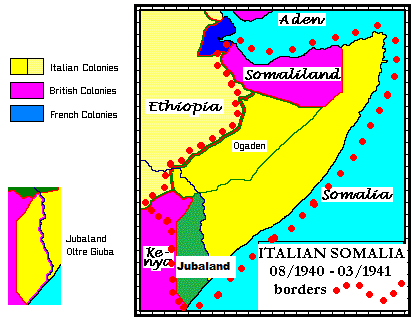Mogadishu under Italian rule
Mogadishu under Italian rule was the capital of Italian Somalia in the first half of the 20th century. Mogadishu was under direct Italian control from 1885 until February 1941, but formal control was only officially ended with the recognition of the independence of Ethiopia in the 1947 Treaty of Peace with Italy following the end of World War II.

History
Benadir Company
Mogadishu (or Mukdishu) is mentioned by Marco Polo and described by Ibn Batuta as an “immense” city. This was in the early part of the 14th century.....In 1892 it was transferred to Italy. The name of the town is spelt in a great variety of ways, including Madeigascar, whence the name of the island of Madagascar. Alfred Grandidier points out that the Portuguese, misled by Marco Polo's description of Mukdishu as an island, fancied they had discovered the land of which he wrote when they touched at Madagascar 1911 E. Britannica
The first Italian to write about "Mogadiscio" was Marco Polo, who knew of the city during his merchant travels in Asia. Italians entered the city only in the late 19th century, however, when the Italian chartered company Compagnia Filonardi, owned by Vincenzo Filonardi took control of facilities in the port of Mogadishu.
The city of Mogadishu came under Italian control in the 1880s after the Kingdom of Italy acquired the territory of Italian Somaliland. The early Benadir Company was a successor to Filonardi compagnia, both of whom were private companies whom nonetheless acted under the orders of the Italian government.[1]
Direct governance
In 1905, it was made the capital of the territory. Due to Benadir Company difficulty with local discord, Italy began direct governance in 1906. The Italians subsequently referred to the city as Mogadiscio. After World War I, the surrounding territory came under Italian control with some resistance.[2][3]p. 28
Thousands of Italians settled in Mogadishu and founded small manufacturing companies. They also developed some agricultural areas in the south near the capital, such as Janale and the Villaggio Duca degli Abruzzi (present-day Jowhar).[4]p. 233 In the 1930s, new buildings and avenues were built. A 114 km (71 mi) narrow-gauge railway was laid from Mogadishu to Jowhar. An asphalted road, the Strada Imperiale, was also constructed and intended to link Mogadishu to Addis Ababa.[5]p. 41
World War II
In 1940, the Italo-Somali population numbered 22,000, accounting for over 44% of the city's population of 50,000 residents.[6][7] Mogadishu remained the capital of Italian Somaliland throughout the latter polity's existence. In February 1941, during World War II it was captured by British forces.
After World War II Mogadishu was made the capital of the Trust Territory of Somaliland, an Italian administered fiduciary political entity under the ONU mandate, for ten years (1950–1960).
 Mogadishu Market, 1882
Mogadishu Market, 1882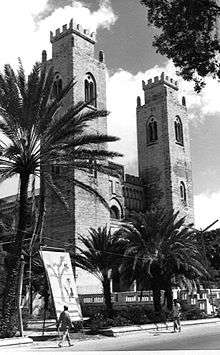 Mogadiscio cathedral, before the beginning of the Somali Civil War
Mogadiscio cathedral, before the beginning of the Somali Civil War Porta ai Giardini, 1931
Porta ai Giardini, 1931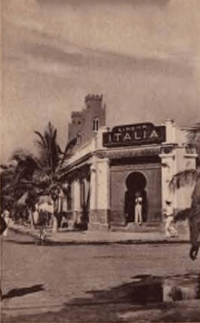 Cinema Italia in Mogadiscio, 1937
Cinema Italia in Mogadiscio, 1937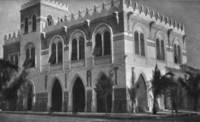 Fiat building in Mogadiscio, 1940
Fiat building in Mogadiscio, 1940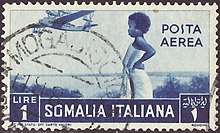 Italian stamp from Mogadiscio, 1936
Italian stamp from Mogadiscio, 1936
See also
- Italian Somalia
References
- Cassanelli, Lee V. "The Ending of Slavery in Italian Somalia: Liberty and the Control of Labor, 1890-1935." The End of Slavery in Africa (1988): 308-331.
- Ade Ajayi, J. F. (1989). Africa in the Nineteenth Century Until the 1880s. UNESCO. p. 387.
- Hamilton, Janice (2007). Somalia in Pictures. Twenty-First Century Books.
- Bevilacqua, Piero; Clementi, Andreina De; Franzina, Emilio (2001). Storia dell'emigrazione italiana (in Italian). Donzelli Editore. ISBN 978-88-7989-655-9.
- Eichstaedt, Peter H. (1 October 2010). Pirate State: Inside Somalia's Terrorism at Sea. Chicago Review Press. ISBN 978-1-56976-774-0.
- Termentin, Fernando (13 May 2005). "Somalia, una nazione che non esiste" (in Italian). Pagine di Difesa. Archived from the original on 5 November 2013. Retrieved 2 January 2014.
- "Il Razionalismo nelle colonie italiane 1928-1943 - La "nuova architettura" delle Terre d'Oltremare" (PDF). Fedoa. Retrieved 2 January 2014.
